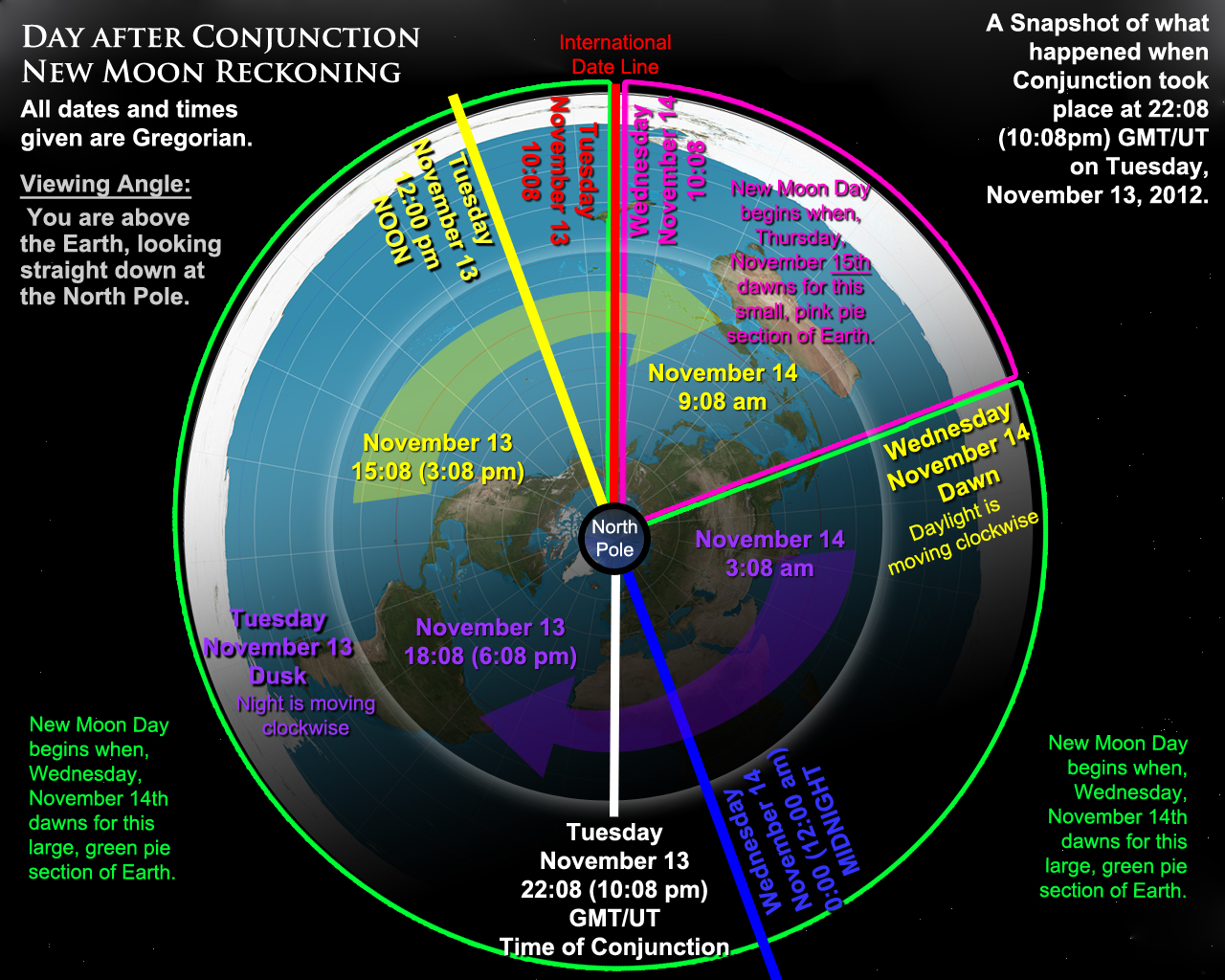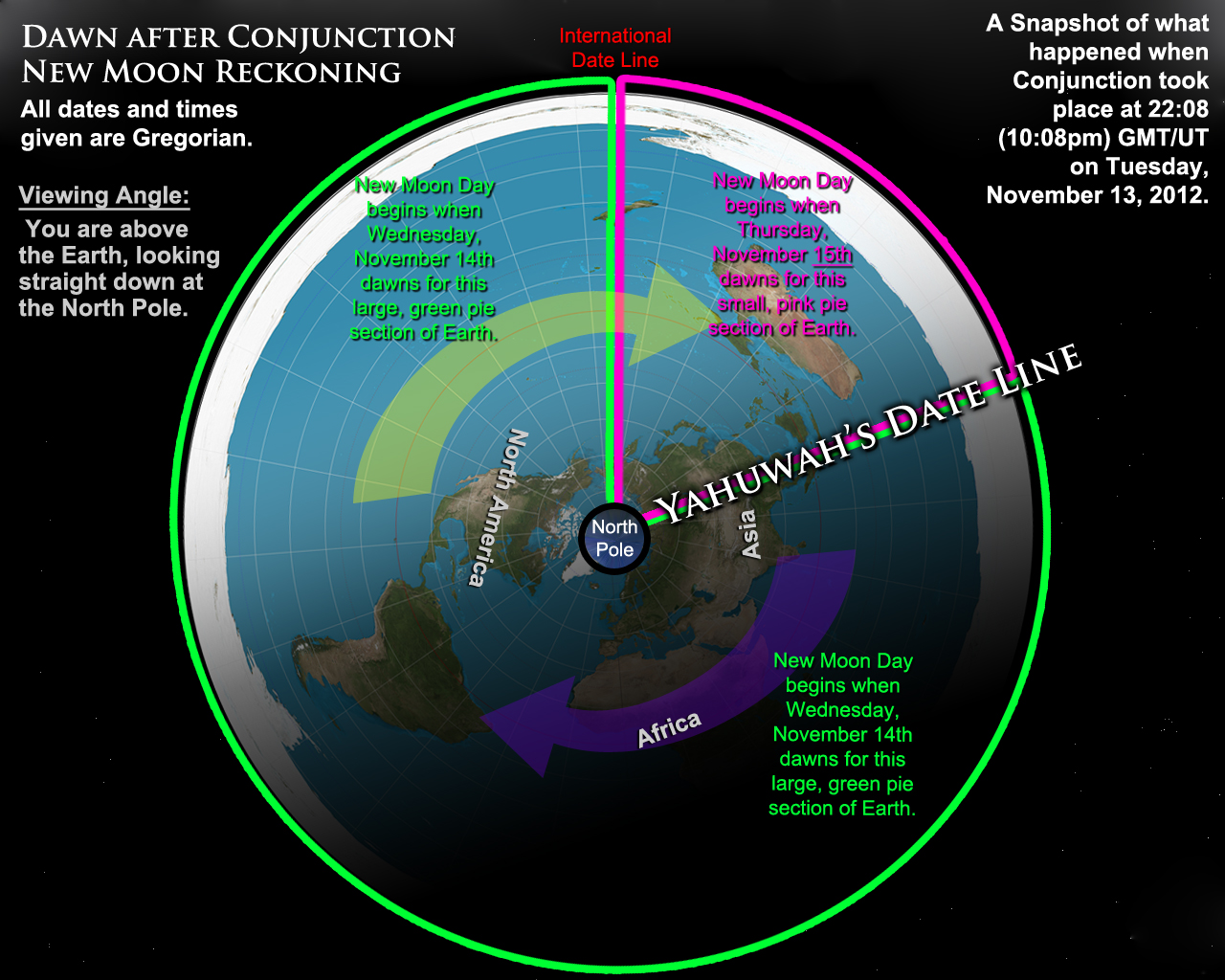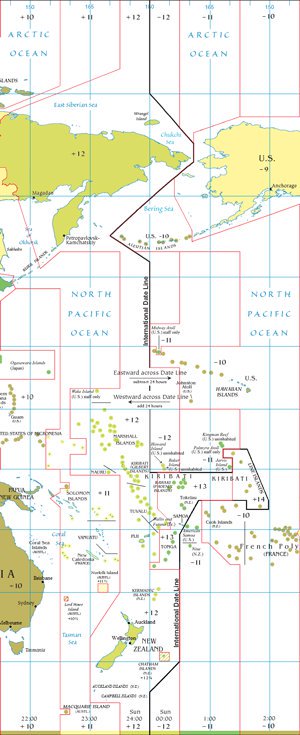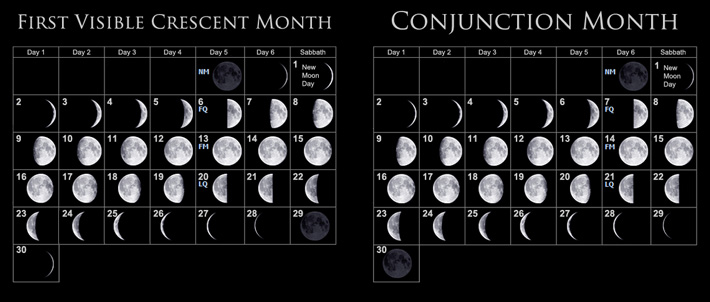The Biblical Argument
There are two main arguments, which have compelled WLC to embrace the First Dawn After Conjunction method for reckoning New Moon Day: (1) The Biblical Argument; (2) The Historical Argument
(I) The Biblical Argument
The Necessity of Keeping Yahuwah's Holy Days in their Season (Lev. 23:4)
These are the feasts of Yahuwah, even holy convocations, which you shall proclaim in their seasons [appointed times]. (See Leviticus 23:4.)
The divine command to keep Yahuwah's holy days at their appointed times cannot truly be met and obeyed except through the First Dawn After Conjunction method. We firmly believe that there is one Sabbath day to be kept by the whole world, and that the whole world is to keep Yahuwah's feasts on a specified day, and not over several days. The First Dawn After Conjunction method uniquely and miraculously unites the entire world on one solar revolution. Here is how it works:
When reckoning the dawn after conjunction as the beginning of New Moon Day, the entire world will be united in observing the same day. While it might appear that two different days are being observed when communicating the dates via the Gregorian calendar, in reality everyone on earth will be observing the New Moons, Sabbaths, and Feast Days during the same solar revolution, each beginning their day within the same 24-hour period. In other words, all countries of the world will experience the arrival of His Sabbath and Feast Days within one 24-hour solar revolution. Thus, the whole world is truly unified in beginning His Holy Days within one 24-hour period. Using this method, a divinely-appointed worldwide Date Line is established each month by the Creator.
The first visible crescent method for reckoning New Moon Day, however, cannot consistently unite the world in beginning the feasts in the same 24-hour revolution. Scripture commands us to observe the Sabbath, not a Sabbath. Does it then make sense that there would be multiple Sabbaths in the same week? Does it make sense for different locals to celebrate the Sabbath 48 hours apart? Only by reckoning the day after conjunction as New Moon Day can everyone on Earth consistently observe one Sabbath Day.


This method allows the entire world to begin their New Moons, Sabbaths, and Feast Days
on the same 24-hour Solar Revolution.
The International Date Line...
 The International Date Line (IDL) is simply an imaginary line that was devised by the International Meridian Conference in Washington, DC in October 1884 CE. The Conference was comprised of astronomers and representatives from 25 countries.1 The participants created the first IDL with little or no regard for the island nations that it divided. Today, the IDL roughly zig-zags its way through the Pacific Ocean around the 180° longitude, basically dividing the world into two Gregorian calendar dates. There is no natural phenomenon that happens there; in other words, it is completely arbitrary. The location of the IDL was chosen because it is situated exactly opposite of the Prime Meridian (yet another completely arbitrary, man-made construct) and the point of Coordinated Universal Time (UTC) or Greenwich Mean Time (GMT). It is also predominately over the ocean. Time and dates plug along in what seems to be an orderly and predictable fashion, completely detached from signifiers in nature, much like a machine that has been wound up and let go. As you can see by the image to the left, the IDL and subsequent time zones are very complex.2 They were designed by man relatively recently and are entirely random in their locations. Is this the way that our Loving Creator designed His time to be structured? What does Scripture say about calendation?
The International Date Line (IDL) is simply an imaginary line that was devised by the International Meridian Conference in Washington, DC in October 1884 CE. The Conference was comprised of astronomers and representatives from 25 countries.1 The participants created the first IDL with little or no regard for the island nations that it divided. Today, the IDL roughly zig-zags its way through the Pacific Ocean around the 180° longitude, basically dividing the world into two Gregorian calendar dates. There is no natural phenomenon that happens there; in other words, it is completely arbitrary. The location of the IDL was chosen because it is situated exactly opposite of the Prime Meridian (yet another completely arbitrary, man-made construct) and the point of Coordinated Universal Time (UTC) or Greenwich Mean Time (GMT). It is also predominately over the ocean. Time and dates plug along in what seems to be an orderly and predictable fashion, completely detached from signifiers in nature, much like a machine that has been wound up and let go. As you can see by the image to the left, the IDL and subsequent time zones are very complex.2 They were designed by man relatively recently and are entirely random in their locations. Is this the way that our Loving Creator designed His time to be structured? What does Scripture say about calendation?
And Elohim said, ‘Let there be lights in the firmament of the heaven to divide the day from the night; and let them be for signs, and for seasons, and for days, and years… (Gen 1:14)
Using the Creator’s Calendar and His divinely ordained luminaries in the sky, nothing is arbitrary or insignificant. The phases of the moon, the rising and setting of the sun, and even the position of the stars are all relevant.3 When using the Creator’s Calendar, the first dawn after the Lunar/Solar Conjunction marks the beginning of the date line. Dawn then moves forward from that point bringing with it New Moon Day to the world. This method will ultimately unite the whole world on one 24-hour solar revolution which is not possible with any other method for reckoning the New Moon. This method gives the sun and the moon back their governance over the seasons, or môʿēd < Strong's H4150>, the month, the Sabbaths, and the Feasts. If the “Dawn After Conjunction” method had been kept throughout the centuries since creation, there would have been no reason to conjure up the man-made IDL. Although Yahuwah's date line, which could also be called His "dawn line", changes geographically from one month to the next, the Dawn after Conjunction is the one lunar method that miraculously unites the whole world on one 24-hour solar revolution. (It will be discussed later why the Full Moon cannot serve as the New Moon. Refer to the section, entitled "Problems with Using the Day following the Full Moon".)
Not only does this method unite the world in observing the Feasts on one 24-hour Solar Revolution, but none will begin New Moon Day more than 24 hours after the actual Conjunction takes place. Remarkably, there are only 24 hours from the time of Conjunction until New Moon Day dawns in the last geographic region to receive the day. This is an amazing testimony to the uniqueness and consistency of Yahuwah's worldwide date line.
1 http://www.staff.science.uu.nl/~gent0113/idl/idl_imc1884.htm
2 http://en.wikipedia.org/wiki/File:International_Date_Line.png
3 The position of the stars in relation to the Sun and the Moon in regards to Biblical calendation is something that the WLC Team continues to study.
Consistency: Beginning the Day at Dawn (as opposed to sunrise)
A Biblical day begins at dawn, at the earliest introduction of light, and ends at dusk, with the complete absence of light. In a consistent pattern, the month begins with the first dawn immediately after the moon becomes illuminated and ends when the moon is completely void of light at the conjunction. (Not being able to see the moon's initial illumination does not change the reality that it is taking place. The light of the first visible crescent is only evidence of what began taking place immediately following the moon's conjunction with the sun.)
The New Moon: Chodesh (H2320)
The Hebrew word for "New Moon" is chodesh (H2320), which is also translated as "month." Chodesh appears in Scripture more than 270 times, yet it is not used even once to denote seeing something (i.e. the visible moon, the crescent, etc.). Rather, the Hebrew word signifying the physical, observable moon is yerach (H3391, H3393, & H3394). Yerach is translated 28 times as "moon" and 13 times as "month," but is never used to signify the New Moon.
Note: There is a Hebrew word for "crescent" - śaharōnîm (H7720). However, it is used exclusively in connection to heathen idolatry (Judges 8:21 & 26; Isaiah 3:18), and is never associated with the "New Moon" or even the "month." More on this later. Refer to the section below, entitled "Problems with Using the First Visible Crescent ."
Psalm 81:3
"Blow up the trumpet in the new moon, in the time appointed [H3677], on our solemn feast day [H2282]." (Psalm 81:3, KJV)
H3677 (keh'-seh) - Apparently from H3680; properly fulness or the full moon, that is, its festival: - (time) appointed. (Strong's Greek & Hebrew Dictionary)1
H2282 (khag) -This word refers especially to a "feast observed by a pilgrimage." (The New Strong's Expanded Dictionary of Bible Words)
Psalm 81:3, then, tells us two things:
- A trumpet (shofar) was to be sounded at the New Moon.
- A trumpet (shofar) was to be sounded at the full moon, at the time of a pilgrimage feast.
In context, Psalm 81 is talking about Israel's exodus from the land of Egypt. It seems only reasonable to conclude then that the pilgrimage feast being referred to here is the Feast of Unleavened Bread, which begins on the 15th day of the lunar month (on the same day that the children of Israel were led out of Egypt). Some have suggested that Psalm 81:3 is referring to the Feast of Trumpets (New Moon Day) and the Feast of Tabernacles (beginning on the 15th) in the seventh month. This seems unlikely given the context of the entire chapter. However, even this interpretation places the full moon at the end of the second week on the 15th of the month. There is no way to honestly reconcile this verse with the first visible crescent methodology for reckoning New Moon Day, as the first visible crescent method generally places the full moon on the 13th/14th of the month. Reckoning the day after conjunction as New Moon Day, however, places the full moon on the 14th/15th of the month, which is in harmony with Psalm 81:3. (This is also in harmony with The Writings of Philo. See "The Historical Argument" below.)
Scripture provides three further important details about the Exodus.
- It occurred at night;
- It took place on the 15th of the month.
- It suggests that there was a FULL MOON at that time – the MIDDLE of the month.
Deuteronomy 16:1 - "Observe the month of Abib, and keep the passover unto . . . [Yahuwah thy Elohim]; for in the month of Abib . . . [Yahuwah thy Elohim] brought thee forth out of Egypt by night.
Numbers 33:3 - "And they departed from Rameses in the first month, on the fifteenth day of the first month; on the morrow after the passover the children of Israel went out with an high hand in the sight of all the Egyptians."
In addition to the date and time, here, special attention must also be given to the words “in the sight of all the Egyptians" as this suggests that there was a bright FULL MOON at that time – the MIDDLE of the month.

Please Note: This is an ideal representation of the Lunar Month when reckoning by the first visible crescent and the Dawn after Conjunction. Because the Moon can achieve the perfect Quarter, Full, and Conjunction phases at any time during a 24-hour period, and since most (if not all) programs/calendars use a midnight to midnight reckoning of a date, you will sometimes see the perfect phases shown a day earlier or a day later, making them not always line up exactly. When reckoning by the first visible crescent, there is actually more variance (from month to month) than what is shown in the depiction above because there are several variables involved in determining the earliest visibility of the moon. The Dawn after Conjunction method establishes a much more consistent pattern of phases.
1 Some have suggested that keh'seh, based on its root word (H3680; kâsâh), should be translated as "concealed moon" as opposed to "full moon," meaning that the trumpet should be sounded when the moon is dark (i.e. conjunction) to signal New Moon Day. Even this interpretation is in harmony with the dawn after conjunction method of reckoning.
Genesis 1
Darkness (an actual segment of time) preceded day one of Creation week. That is to say that the very first day of the very first month in Earth's history was dark; no light preceded this day. Why should we expect subsequent months to be any different?
"In the beginning Elohim created the heaven and the earth. And the earth was without form, and void; and darkness was upon the face of the deep. And the Spirit of Elohim moved upon the face of the waters. --- And Elohim said, Let there be light: and there was light." (Genesis 1:1-3, RNKJV)
Ezekiel 46:1 & Nature's Testimony
Ezekiel 46:1 establishes that there are three different types of days: (1) New Moon Days; (2) Work Days; (3) Sabbath Days
Thus says the Master Yahuwah: "The gateway of the inner court that faces toward the east shall be shut the six working days; but on the Sabbath it shall be opened, and on the day of the New Moon it shall be opened." (See Ezekiel 46:1.)
It stands to reason that the different classes of days would be delineated in nature (Creation). When reckoning the dawn after conjunction as the commencement of New Moon Day, we find that each type of day is generally marked by specific moon phases: (1) New Moon Day is preceded by darkness (conjunction); (2) Work days are preceded by the illuminated phases (excluding the quarter phases).1 (3) Sabbath Days are preceded by the quarter phases. Thus, this method makes consistently identifying the Sabbaths by the moon's appearance much easier and more practical. It seems that Creation itself testifies to this method of reckoning.
1 The crescent moon will often be visible to the naked eye on New Moon Day (on the evening before the first day of the workweek), but this will not always be the case.









